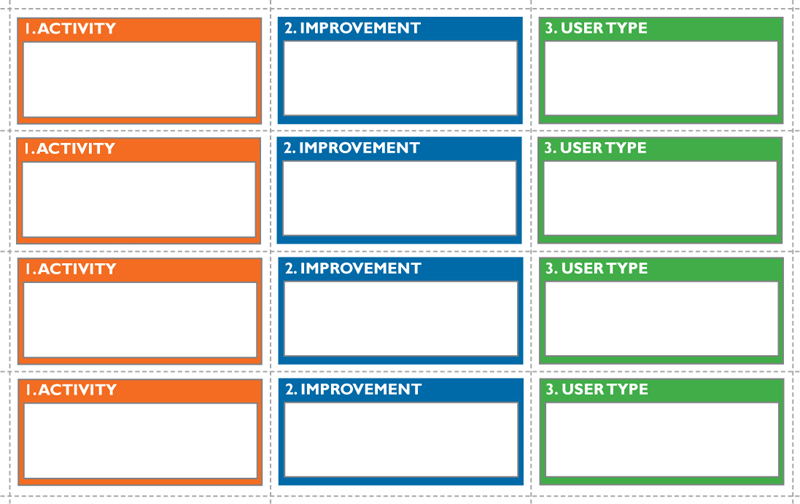Sponge!
You’re About to:
Challenge your own assumptions
Develop your skills in empathy
Learn to read body language
Interview a rock star
Play the anthropologist
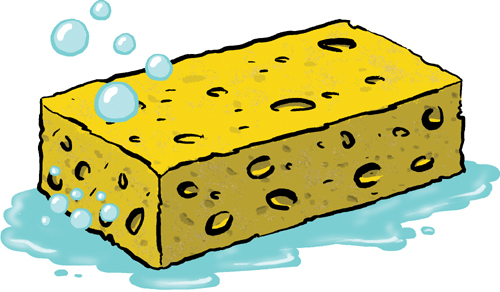
Did You Know?
You’re probably most familiar with manufactured sponges, but those are inspired by animals that live in the sea! Although sponges seem soft, they are actually one of the toughest animals around. If they’re cut up, the pieces will regenerate into new sponges.
Sponges move water in and out of channels in their bodies, filtering their food from the water. In this chapter, like a sponge, you’ll soak in information and filter it for the elements that will help you generate design ideas.
If you had to pick a body part that’s most closely associated with the act of designing, you may think of HANDS. After all, designers are creating all sorts of things, from websites to houses. And to create these things, designers use their hands to sketch out ideas with pen and paper, or to create models for what they plan to build.
Or, you may pick the BRAIN. You need a good, solid brain to come up with interesting ideas and to plan out the details. Without question, the brain is deeply involved throughout the whole process of design.
But before an idea of yours becomes really solid, your brain has to partner up with your EYES and EARS, to observe and listen to people. Like a sponge, you must soak in everything that surrounds you so you can understand how people think and act, and figure out what they really need. You also ought to absorb the environment around them and the tools they use from day to day. Designers call these things the “context of use” for the products they design.
In this chapter, you’ll explore ways to sponge up details of the world around you so that you can form relevant design ideas. And to be really creative, you have to soak in information that’s outside of your daily routine.
![]() Warning!
Warning!
It can be hard to observe things without bias getting in the way! You’re a human being,* and humans tend to make assumptions about other humans. Sometimes assumptions are correct and sometime they mislead you. That means it’s important to know when you’re making them, and to validate them as true or false.
*The authors have made an assumption that you’re a human being, and we apologize to all other intelligent life forms including but not exclusive to: aliens, monsters, talking animals, fairies, leprechauns, winged monkeys, comic book characters, action figures, and alternate-universe versions of human beings (non-evil).
In this adventure you will SPONGE - immerse yourself in the lives of other people so that you can find some good, meaty problems to solve through design. You’ll also gain an important context that will help you generate ideas and make good design decisions later!

Questions to Ponder:
• How do you a solve a problem that’s not your own?
• How do you find out if you’re making the wrong assumptions about someone or something?
• Why don’t people always say exactly what’s on their minds? How can you tell when they don’t?
What You’ll Do:
• Figure out the assumptions you have made about people. Find out if there’s truth to them - or if the assumptions are wrong! If you design with the wrong assumptions, your creation may never be used.
• Learn about the people you’re designing for by asking good questions (and yes, there are bad questions!).
• Develop skills in active listening and observation, to go beyond the words people say - and gather information that will give you true insights.
Working with Assumptions
Assumptions are ideas you’ve formed about people or situations, based on your past experiences or on things you’ve heard from other sources.
For example, you may make the assumption that CIA officers are always running around in exotic locations, especially if you’ve seen them only in movies or on TV. (In reality, most CIA officers spend a lot of time behind a desk.)
When you’re designing something, it’s important that you identify the assumptions you’re making and understand when they might be causing you to form the wrong conclusions. Don’t ignore your assumptions completely, but write them down and then validate them - prove them true, untrue, or only sometimes true - by going into the field and conducting research. Observe the people you’re designing for, and ask them well-formed questions. You’ll gain a lot more real-world information that way.
If you don’t get out into the field to observe people and talk to them, you will use only your assumptions as a basis for understanding the people you’re designing for. Designing under those circumstances is difficult - if not impossible - to do well!
So, you’ll be heading out into the field to observe people and ask them questions! Before you get started, let’s find out what makes a good question good, and a bad question bad.

Game: Field Character Study
Goal
Hone your observational skills and avoid the pitfalls of assumptions by correctly guessing what a stranger is going to order at a cafe.
What You’ll Need
Whatever best enables you to quickly and easily record your observations: pen and paper, tablet, laptop, etc.
Step 1: Set Up in the Field
Go to a (preferably busy) coffee shop or cafe, and set up at a table with a clear view of the customer line, register, and order/delivery area.
Step 2: Watch & Record
Pick a person - any person! - at the end of the line. Begin recording as many observations about that person as possible. Try to jot down at least 10 observations before he (or she) gets near he front of the line.
Step 3: Make a Guess
When the person nears the front of the line, guess what he will order based on your observations. Write down your guess.
Step 4: Check Your Guess
What did the person you were observing finally order? Write down the actual order next to your guess.
Step 5: Repeat!
Go through Steps 1-4 again with at least eight different people. Try to pick people of many different ages and types.
Step 6: Analyze Your Results
Were there any similarities among the people for whom you guessed correctly? What assumptions did you make that were correct? What assumptions did you make that were incorrect? Isolate those assumptions as statements. For example, “I guessed younger people would order sweeter drinks because I assumed kids eat more sugar.” When are assumptions helpful? When are they inhibiting? Were you able to guess correctly for the majority of people in your study?
Game: Maître Do, Maître Don’t
Goal
Level up your investigative skills and correctly guess what your partner would order from a menu. (No cheating!!! Don’t peek at the menu until after you have completed Step 2.)
What You’ll Need
• Something to write with
• Stopwatch or clock
Step 1: Quiz Your Partner
Interview your partner about his or her preferences. You will use these interview results to judge what your partner would order off a menu, so try to ask questions that can help you quickly rule things in or out. For example, don’t ask, “Do you like ice cream?” Instead, a better question might be: “Do you have any food allergies?” And if the answer is yes, “Which ones?”
Step 2: Your Turn to Be Interviewed
Spend five minutes answering questions from your partner. Be honest!
Step 3: Check Out the Menu
Flip to page 141 and explore the menu on your own. Don’t talk about it with your partner yet. Bon Appetit!
Step 4: Place Your Order
Imagine that you have $20 to spend. What would you get? Record your order, and don’t worry about tax or tip. You only get five minutes to make up your mind. Your partner should be deciding what she would order too.
Step 5: Order for Your Partner, Too
What do you think your partner would order with her $20? Write down your guess.
Step 6: Compare Orders
Who was able to guess more dishes correctly - you or your partner? That person is the winner!
However, everybody wins when you ask good questions. Probe your reasoning with the aid of your partner. Why did you pick certain items for her? On which of your interview questions did you base your assumptions? Explore the question/assumption tactics that were the most successful.
Creating Research Questions
You can ask many kinds of questions during an interview. Think of those questions as being either skinny or fat.
Skinny Questions
Skinny questions can be answered in just a few words - sometimes only one! For example, if you ask, Did you floss your teeth before leaving the house today?, you’ll probably get a “yes” or “no” answer. Skinny questions may also be called closed questions because they have a small set of common answers, and sometimes those answers can be proven true or false. If your interview subject answers “yes,” but someone else was there and knows he didn’t, he may be busted!
Generally, skinny questions are better for surveys or quizzes like those you take online. They allow you to compare simple answers across a large number of people, so you make statements like “Twenty percent of those surveyed answered that they did floss that morning.”
Fat Questions
Fat questions can’t easily be answered with one or two words. They require the subject to explain her opinion or rationale for doing something, or to explain a process she uses. If someone says she doesn’t like to floss, you could ask her, “What do you dislike about flossing your teeth?” The question is more open because the person needs to think about flossing and identify her own reasons for disliking it. Perhaps it’s because she thinks flossing takes too much time, or because her gums are sensitive and it’s uncomfortable for her to floss.
Fat questions are better for interviews that you conduct in person or over the phone. They lead to more detail about a particular person’s experience and give you a richer understanding of her thoughts and feelings.
Activity: Rock On,___________!

Write the name of your favorite rock star on the line above. Now write down some questions you’d ask him or her during an interview.
Skinny Questions

Fat Questions
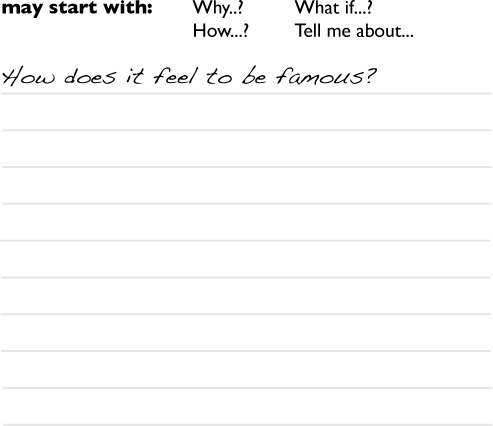
Activity: Lasso the Leaders
When writing a question for research, try to avoid writing it in a way that implies a particular answer or that assumes a person already feels a certain way. These are called leading questions because they lead people to an answer, whether or not that answer is the honest one.
It’s also good to avoid asking questions that seem to accuse people of something (which can make them feel uncomfortable) or that use extreme words such as “always” (because people rarely do the same thing all the time).
Circle the letters of questions below that are badly worded, and explain why you chose them. We started you off with one answer. When you’re ready, you’ll find the rest of the answers on page 142.
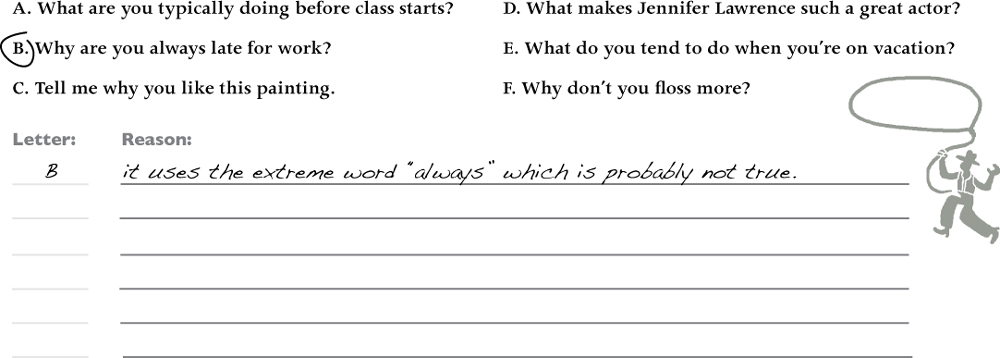
Active Listening
Asking good questions is a very important skill when gathering information, but just as important is the ability to not just hear, but really listen to the responses you get.
Active listening is a technique that assures your interviewee that you sincerely care about what he’s saying, and helps you identify areas where you may not be understanding him correctly. When you demonstrate active listening, you can build trust, avoid misunderstandings, and have more open conversations.
One great technique is to repeat a person’s answer back to him to confirm it. When you do this using words that are similar (but not identical) to his, you’re paraphrasing. Here’s an example:

You: How do you feel when you’re about to go to the dentist?
John: I get a bit nervous, every time I’m about to head into the room!
You: So the visit with the dentist makes you nervous?
John: Well, I don’t mind the actual teeth cleaning, which is all that usually happens. But what if she finds a cavity or tells me I need to have a root canal? Most of the time she doesn’t find anything that needs a fix, but I definitely heave a sigh of relief when I know for sure!
Body language is also a key part of active listening. If people are uncomfortable, they won’t be as engaged with the questions you’re asking, or as open about their responses. Let’s take a closer look at what we say without using words.
Basic Body Language
You’ll get better information from a person who’s relaxed. How can you tell when a conversation is going well?

It’s in the Smile
People who are uncomfortable, or just not completely engaged in a conversation, will often smile politely - but their faces give them away. A tighter face usually represents a fake smile. A genuine smile is more relaxed, and leads to more crinkling of the eyes and a wider grin. You may also notice that a head tilt and shoulder movement goes with a real smile, like the person is giving a small laugh.



Which of the smiles in this second row are genuine, and which are fake?

Answers on page 143
The Next Top Model
Once you better understand a group of people through observation and interviewing, you can create a model of them, which is a diagram that visually expresses your understandings. Having a user model will help you later when you’re trying to design for the group, and need to remember what you’d seen and heard from them. It will also help you represent them to other people on your design or development team.
There are several kinds of user models. Here are a few of the most common:
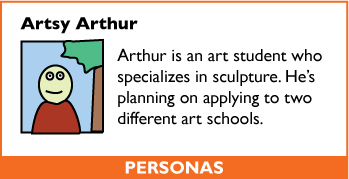
Personas are small, focused biographies of a fictional person. They’re meant to represent the goals, activities, frustrations and motivations of a specific type of user.
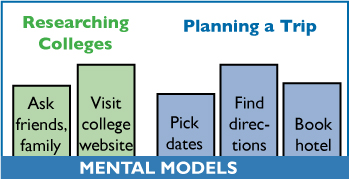
Mental models represent user behaviors and steps related to a goal, such as “visiting potential colleges.” They highlight the ways people think about the goals and the activities involved.

Journeys are sequential models representing behaviors and feelings over a longer period of time, like a journey for applying for, being accepted to, and attending a college.
Ideally, all of these models are based on research that you’ve completed with a larger group of potential users - for example, 12 to 30 people. The models represent key trends and common needs found during your research.
We won’t be delving deeply into models in this book, but if you want to level up and try your hand at personas or other models, you can find more information at the end of this chapter in “Challenges You Can Chew.”
A persona-style model is still a useful way to represent the people you’re interviewing, so take a look at an example. You’ll be using a similar format to capture profiles during your final challenge. Which begins... now!
Spotlight: Personas
Ben uses:
About Ben
Goals
• Study and intern abroad in Copenhagen for a year
• Gain the experience that will help him start working immediately after completing his undergraduate degree
Frustrations
• Ben is learning hard skills in his classes, but hasn’t been able to apply them to any jobs or internships directly related to his area of interest.
• Writing a resume can be difficult. He wants to highlight the skills he’s taking in class, but most job sites focus on professional experience.
Activities
• By day, Ben attends class, plays flag football, and volunteers with his fraternity.
• By night, he works part-time and occasionally attends on-campus workshops about finding internships and jobs.
Personas are not real people themselves, but they pull together insights you’ve gotten from talking to a number of real people in the same general group.
For example, if you’re trying to design a site that allows students to find internships in their areas of interest, you may create a persona like Beginner Ben.
You would interview or survey several students to find out their:
Goals: The main things they want to accomplish, related to the problem you’re trying to solve
Frustrations: Aspects of the current situation that are causing them pain or annoyance
Activities: Tasks they have to accomplish, or events they have to react to
Demographics: Facts such as age, location, income, and ethnicity
When you’re designing, personas help you think of the features a group will need and care about, and how to best address them.
The SPONGE challenge!
For your final chapter challenge, choose a Challenge statement, and then get out in the field to sponge up information that you’ll take into the next step! Your Challenge should have the form of:
“Make.... [this activity] [improved in this way] for [this user type].”

To come up with a lot of statements at once, try mixing and matching options from different columns. (In the current table, for example, you could decide to make “driving more fun for parents of small children.”) Or get together with a couple of friends, and each of you choose a different column and list four things in that column using the cut-out cards on the next page. Read them off by number and mix and match between you to build statements that make sense (not all of them will). Pick one and discuss what that Challenge statement means to you.
Decide on a Challenge statement. Then find three to five people who represent the chosen type of user, and interview them to better understand their current context. Try to observe people before and after the interview as they go through that activity. You can use the following worksheets to help you get started.
Make a Plan, Man
Write down the assumptions you have about the activity you’ve chosen.
Where do people tend to do it?
________________________________________________________________________
What materials or tools do they need (a car, a pencil, a mobile phone)?
________________________________________________________________________
Why is it important to improve this activity for this user group? What are the consequences now without that improvement?
________________________________________________________________________
________________________________________________________________________
Who are you going to interview? Where?
________________________________________________________________________
________________________________________________________________________
What particular activities would you like to have them show you, or describe? (For driving, you could include getting gas, dealing with traffic, and parking.)
________________________________________________________________________
________________________________________________________________________
Now, write up at least 10 questions that help people share their experiences. Interview three to five people from your user group, and use information from their answers to fill out a profile for each person. Good luck!
Profile of (Name): ________________________________________________________________________

Personal info:
Age:
_______________________________
Location:
_______________________________
_______________________________
Other Facts:
_______________________________
_______________________________
_______________________________
_______________________________
_______________________________
_______________________________
About this Person:
________________________________________________________________________
________________________________________________________________________
________________________________________________________________________
________________________________________________________________________
Goals:
________________________________________________________________________
________________________________________________________________________
________________________________________________________________________
Frustrations:
________________________________________________________________________
________________________________________________________________________
________________________________________________________________________
Activities:
________________________________________________________________________
________________________________________________________________________
________________________________________________________________________
The Debrief
Now you should have a nice, chaotic mix of notes, pictures, pamphlets and other fun artifacts that represent the information you’ve collected during your interviews and observations.
If you have a spare wall, or a moveable poster, you could make a collage of your artifacts and pictures. This will help you in the next chapters as you think of ideas for solutions to design.

Maybe you already have some ideas about specific problems you’d like to solve rolling around in there, too!
In the next chapter we’ll talk about about digging into your insights to find ideas that address real needs, and perform some basic sketching exercises that will help you move from communicating with words to communicating visually.



